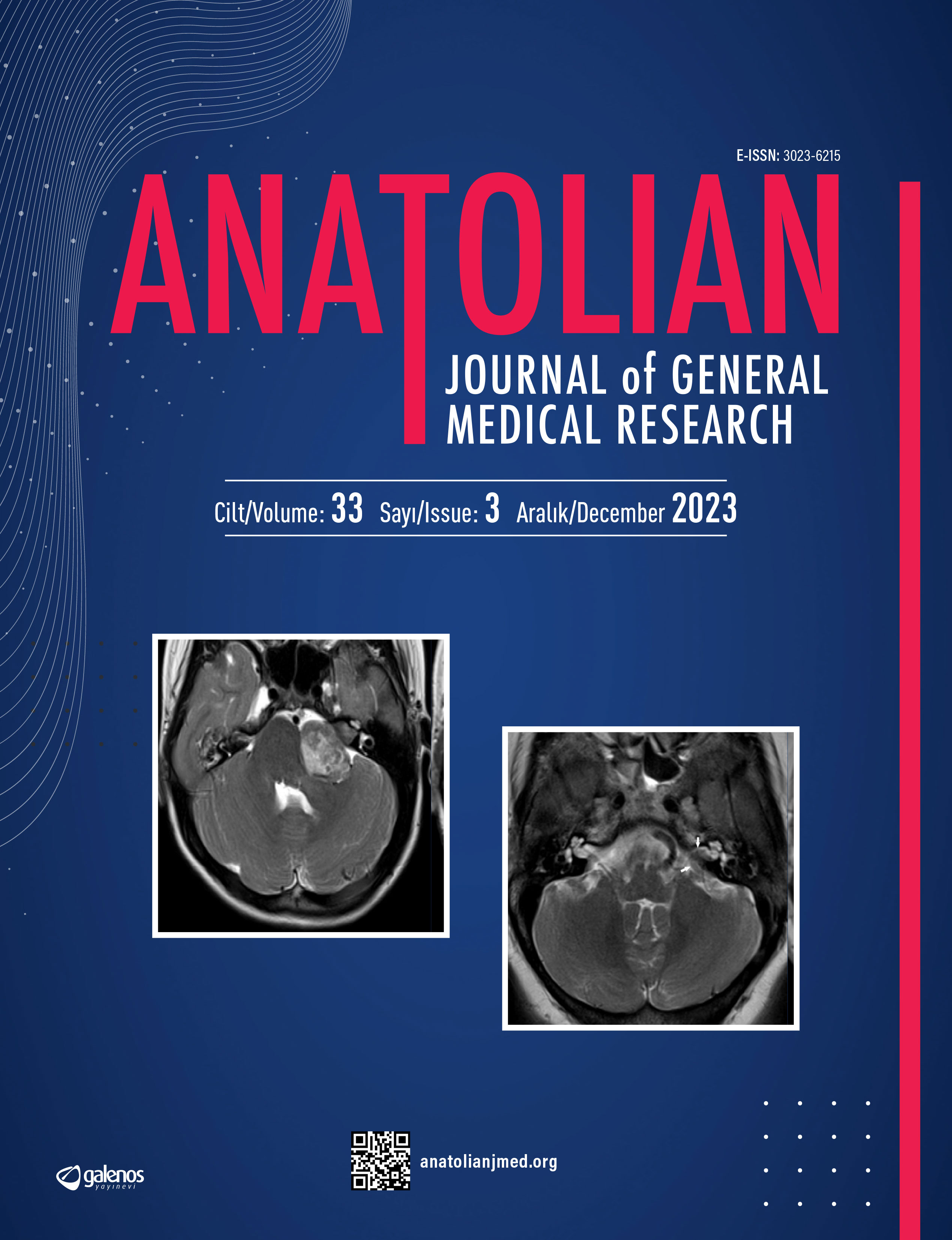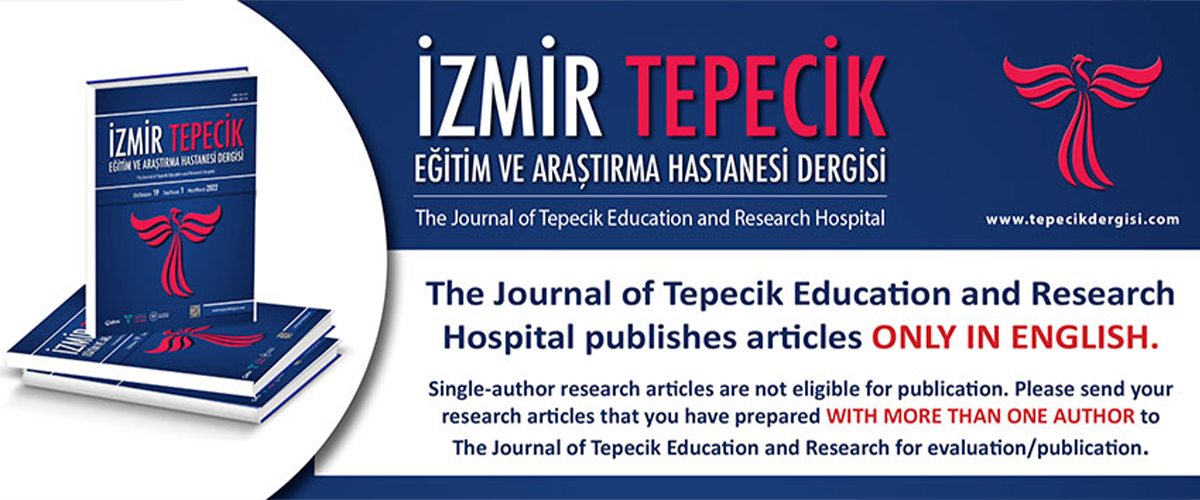








Two Different Radiotherapy Schemes: Flowing Cisplatin and Vinorelbine Treatment in Stage III-B Non-Small-Cell Lung Cancer
Serdar Özkök1, Tuncay Göksel2, Ufuk Yılmaz3, Serra Kamer1, Gülruh Polat3, Ayfer Haydaroğlu1, Tülin Aysan21Ege Üniversitesi Tıp Fakültesi, Radyasyon Onkolojisi Anabilim Dalı, İzmir2Ege Üniversitesi Tıp Fakültesi, Göğüs Hastalıkları Anabilim Dalı, İzmir
3Suat Seren Göğüs Hastalıkları ve Göğüs Cerrahisi Eğitim Hastanesi, İzmir
Aim: To evaluate the toxicity, tumor response and suruiual rates of two different radiotherapy schemes (RT) following 2 cycles of cisplatin (CP) and vinorelbine (VN) chemotherapy and to determine the potentiai prognostic factors of survival. Methods: Eighty nine cases with proven stage III-B non-small-cell lung cancer were given 2 cycles of CP (80 mg/m2/Dı)-VN (30 mg/m2/D1,D8) every 3 weeks. Then 49 patients were treated with 66 Gy conventional external radiotherapy (CRT) and 32 with 69.6 Gy hyperfractionated external radiotherapy (HRT). SPSS 9.0 Computer programming was used for statistically analysis. OveralI survival were estimated using Kaplan- Meier method, Uni-variate analysis was done using log-rank method and multi-variate analysis were done using cox proportional hazard method. Results: Median age was 60 (40-70) and 95% of the patients were men. While objective response rate was 48,1% after neo-adjuvant chemotherapy, it was found 75.3% for the total number of the patients. Statistically significant difference was found between the two groups of radiotherapy (p=0.837). Median survival time of the whole group was 14.8 months and 5 year survival rate was 15.3%. Median survival time of the CRT and the HRT groups were 14.8 months and 13.4 months, and the 5 year survival rates were 11.3%) and 21.4%orespectively, with no statistically significant difference between the tuuo groups (p=0.456). The patient characteristics of each radiotherapy group were similar. The rates of grade 3-4 neutropenia, febrile neutropenia, grade 3-4 esophagitis and grade 3-4 pulmonary toxicity were 44.1%, 5.3%, 6.1% and 9.8% respectively. No statistically significant differences were detected among two radiotherapy groups. In uni-variate analyses the prognostic factors for survival were performance status, weight loss, response to neo-adjuvant chemotherapy and to radiotherapy; in multi-variate analyses the prognostic factors were nodal stage, performance status, weight loss, response to neo-adjuvant chemotherapy and to radiotherapy. Conclusions: Radiotherapy- whether given as a conventional or as a hyperfractionated scheme following 2 courses of CP-VN did not differ regarding toxicity, tolerance, response rates and survival.
Keywords: Lung cancer, radiotherapy, hyperfractionated radiotherapyEvre III-B Küçük Hücreli Dışı Akciğer Kanserlerinde, Cisplatin ve Vinorelbine Sonrası İki Farklı Radyoterapi Uygulaması
Serdar Özkök1, Tuncay Göksel2, Ufuk Yılmaz3, Serra Kamer1, Gülruh Polat3, Ayfer Haydaroğlu1, Tülin Aysan21Ege Üniversitesi Tıp Fakültesi, Radyasyon Onkolojisi Anabilim Dalı, İzmir2Ege Üniversitesi Tıp Fakültesi, Göğüs Hastalıkları Anabilim Dalı, İzmir
3Suat Seren Göğüs Hastalıkları ve Göğüs Cerrahisi Eğitim Hastanesi, İzmir
Amaç: İki kür cisplatin (CP), vinorelbine (VN) kemoterapisi (KT) sonrası 2 farklı radyoterapi (RT) uygulamasının toksisite, tümör yanıtı ve sağkalım oranlarının değerlendirilmesi, sağkalım süre ve oranlarını etkileyen prognostik faktörlerin belirlenmesidir. Yöntem: Aralık 1995- Ağustos 2000 tarihleri arasında Ege Üniversitesi Tıp Fakültesi Radyasyon Onkolojisi Kliniğimde Evre III-B küçük hücreli akciğer kanseri tanısı almış 81 olguya 2 kür) kemoterapi [CP (80 mg/m2, 1 gün) ve VN (30 mg/m2, 1. ve 8. gün)] sonrası, nonrandomize olarak 66 Gy eksternal konvansiyonel radyoterapi (KRT) (49 olgu) veya 69.6 Gy eksternal hiperfraksiyone radyoterapi (HRT) (32 olgu) olmak üzere 2 farklı RT şeması uygulanmış, sonuçlar retrospektif olarak değerlendirilmiştir. İstatistiksel analizler SPSS 9.0 bilgisayar programı ile yapılmıştır. Sağkalım süre ve oranları Kaplan Meier yöntemi ile, gruplar arası sağkalım süre ve oranları arasındaki farklara dayalı tek değişkenli analizlerde log-rank testi kullanılmış, çok değişkenli analizlerde ise Cox proportional hazard modelinden yararlanılmıştır. Olasılık değeri (p) olarak 0.05 ve altı istatistiksel anlamlı kabul edilmiştir. Bulgular: Değerlendirmeye alınan 81 olgunun medyan yaşı 60, %95'i erkektir. Neoadjuvan KT sonrası % 48.1 tam ve kısmi yanıt elde edilirken, radyoterapi sonrası tüm olgularda yanıt oranı %75.3'e yükselmiş, her iki RT grubu arasında istatiksel fark bulunamamıştır (p=0.837). Tüm olgularda medyan sağkalım süresi 14.7 ay, 5 yıllık sağkalım oranı %15.3'tür. KRT grubunda bu oranlar sırası ile 14.8 ay ve % 11.3 bulunurken HRT grubunda 13.4 ay ve % 21.4 olarak tespit edilmiştir (p=0.456). Tek değişkenli analizler sonucunda sağkalımı etkileyen prognostik faktörlerin performans durumu, kilo kaybı, neoadjuvan kemoterapiye yanıt ve radyoterapiye yanıt olduğu, çok değişkenli analizler sonucunda ise nodal evre, performans, kilo kaybı, neoadjuvan kemoterapiye yanıt ve radyoterapiye yanıt olduğu belirlenmiştir. Her iki RT grubundaki olgu özelliklerinin benzer olduğu bu çalışmada derece 3-4 nötropeni oranı % 44.1, febril nötropeni oranı %5.3 olarak belirlenmiş, derece 3-4 özofajit oranı %6.1, derece 3-4 pulmoner toksisite oranı %9.8 olarak değerlendirilmiş ve her iki RT grubu arasında istatiksel fark olmadığı tespit edilmiştir. Sonuç: Evre III-B Küçük hücreli dışı akciğer kanserlerinin tedavisinde 2 kür CP-VN sonrası RT'nin konvansiyonel veya hiperfraksiyone uygulanması arasında toksisite-tolerans, yanıt oranları ve sağkalım süreleri arasında fark gözlenmemiştir.
Anahtar Kelimeler: Akciğer kanseri, radyoterapi, hiperfraksiyone radyoterapiManuscript Language: Turkish
(979 downloaded)




